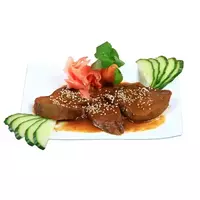Pickled language

Often, modern hostesses and novice culinary experts undeservedly ignore meat offal. For some reason, there was a common opinion that meat offal is second-rate food, from which it will not be possible to prepare exquisite culinary products. We think that first it is worth figuring out what offal is and, as they say, with "what they eat. "
In accordance with the definition used in the food industry, by-products are understood to mean the internal organs of slaughtered pets. In addition, the group of offal includes the so-called less valuable parts of animal carcasses. Offal is classified according to the species of pets. there are pork, lamb or, for example, beef offal, and so on.
It is worth noting especially the fact that in terms of taste and consumer qualities, all meat offal is unequal. In addition, the nutritional value, as well as the vitamin and mineral composition of a particular food product, depends on the type of offal. For example, the liver or tongue refers to incredibly healthy, and besides tasty offal, which in its nutritional value are not inferior to meat. Depending on nutritional value, offal is divided into two main categories.
The first category includes such offal as: tongue, liver and kidneys, as well as brain, diaphragm, beef udder and animal tails. The second group and less valuable in terms of food indicators include such offal as: the head, ears, kaltyk, legs, lips or lungs of animals. Among all varieties of offal, language is especially popular and in demand at all times among both foodies and ordinary lovers of meat products.
In the Middle Ages, peasants could not keep the tongues of slaughtered pets. Only aristocrats could eat languages. Beef, pork or lamb tongue is widely used for culinary purposes. Generally, offal is boiled and marinated or preserved. Pickled tongue is served to the table as a snack in its own right, accompanied by sauces such as table horseradish or mustard.
In addition, pickled tongue acts as an ingredient in the process of making salads, as well as baking fillings or snacks such as tartlets and sandwiches. A special honor among the inhabitants of our latitudes is enjoyed by the salted language. Pickled tongue has a pleasant and tender taste. In addition, the product is enriched with proteins and fats of natural origin.
In order to prepare pickled tongue at home, you should first salt the sub-product and hold it for 6 days. Then the tongue is boiled, peeled and cut into pieces and poured with marinade made from vegetable oil, grape vinegar, as well as garlic, black pepper, thyme or dill. The pickled tongue will be ready for use after a day spent in the marinade in the refrigerator.
pickled language 254 kKal
Energy value of pickled tongue (Ratio of proteins, fats, carbohydrates - ju):
Proteins: 16 g (~ 64 kCal)
Fats: 16g (~ 144 kCal)
Carbohydrates: 0 g (~ 0 kCal)
Energy ratio (b | y): 25% | 57% | 0%
 Español
Español Français
Français Português
Português Русский
Русский 简体中文
简体中文 繁體中文
繁體中文 日本語
日本語 한국어
한국어 العربية
العربية Türkçe
Türkçe Қазақ
Қазақ Deutsch
Deutsch Italiano
Italiano Українська
Українська
